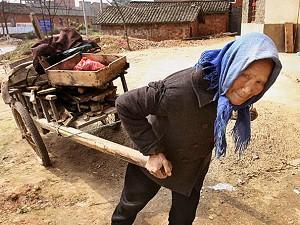The China Development Research Foundation (CDRF) recently released China’s National Development Report for 2007. The report points out that the population of poor in China’s rural areas may be largely underestimated based upon China’s official poverty line of annual 680 yuan ($91) per capita net income.
The internationally accepted standard definition of a poor person is one whose daily income is one US dollar or less. In terms of Chinese yuan (renminbi), those who earn 2,500 yuan (US$333) or less annually in China should be categorized as poor. However, the poverty line set by Chinese authorities is approximately one-fourth the standard set by the international standard.
The report states that over the past two decades, Chinese farmers’ net income has increased substantially. However, China’s official poverty line has remained unaltered since then. Consequently, the ratio of the poverty line to rural net per capita income has continued to decrease.
Some researchers suggest that the current Chinese ratio of the poverty line to rural net per capita income is the lowest in the world. Doubt is therefore being cast on the rationality of China’s poverty line standard. The CDRF’s report states that the poverty line for China’s rural areas may be set at much too low a level. The state of being poor, the report says, does not merely imply whether one has enough to eat, but also correlates with such issues as whether one can live comfortably with food, clothing, accommodation and transport, and whether one has access to education, basic medical care, social contacts, etc.
According to the experts who worked on the report, the current Chinese poverty line may well be considered as the “survival-related poverty line,” which reflects only the income level that a poor person should attain in order to survive. Apart from basic survival, the “development-related poverty line” should be considered, which indicates what the minimum income level is for one to receive a basic education and Medicare. If these aspects were taken into consideration, the report says, the Chinese rural farmers’ development-related poverty line for 2005 would have been set at 1,147 yuan ($153).
China’s poverty line of 680 yuan ($91) per capita net income a year is too low and fails to honestly reflect the progress of its poverty-relief project, according to a researcher at the Chinese Academy of Social Sciences quoted by the report. China’s largely underestimation of rural poverty leads to controversy. On one hand, with its economic boom, China’s per capita Gross Domestic Product (GDP) reaches the standard of a middle power country. On the other hand, China’s rural poor do not feel or share the benefits of the economic rise indicated by the statistics.
Mr. Fang Jue, a Chinese political commentator living in the U.S., pointed out that the Chinese regime deliberately sets a low poverty line standard.
“I am of the opinion that China’s poverty line standard is consciously, instead of unconsciously, set low. Its purpose is to cover up the widening gap in China between poor and rich, and also to conceal the Chinese regime’s serious mistakes in poverty eradication. China sets a poverty line ”defined according to Chinese characteristics,“ which is only one fourth of the international poverty line standard. This is an act to fool Chinese people and the international community,” said Fang Jue.
Fang continued, “China’s poor population actually totals 150 million to 200 million, using the internationally accepted one US dollar per day guideline. This enormous number is much more than the Chinese official estimate. Therefore, poverty reduction still has a long way to go in China, and it will take the Chinese regime a very long time to correct its mistakes in poverty alleviation.”
Dr. Cheng Chuyuan, professor of Economics at Indiana’s Ball State University, said that the Chinese authorities should make massive efforts to improve rural farmers’ lives.
Dr. Cheng commented, “One dollar only helps one stay alive. One dollar maintains survival rather than a minimum standard of well-being in life. What if one is sick? The widening gap between poor and rich should also cover problems concerning Medicare and environmental pollution. If there is no food to eat and clean water to drink, one dollar serves no purpose. China should make vigorous efforts to improve rural living conditions.”
Dysfunctional public services in China’s rural areas have overburdened the rural poor with excessive medical and educational expenses. Medical and educational expenses are a “new contributor to poverty,” according to a member of the China Reform Foundation. The huge burden of medical expenses, in particular, changes rural poverty for the worse.

Friends Read Free